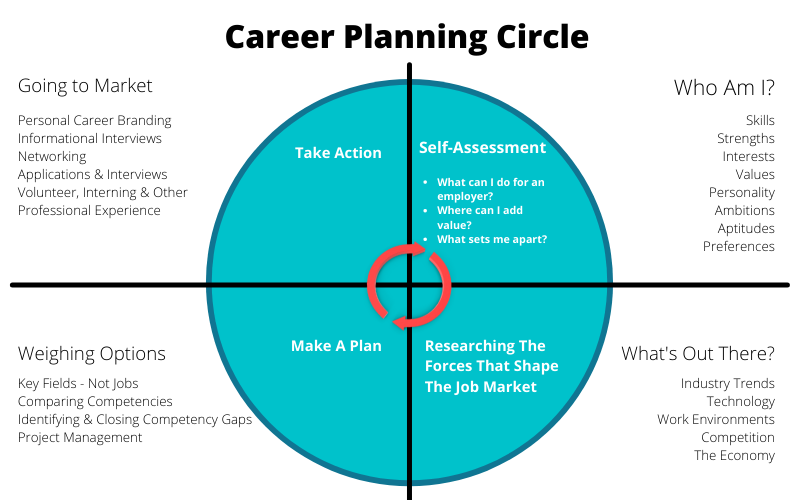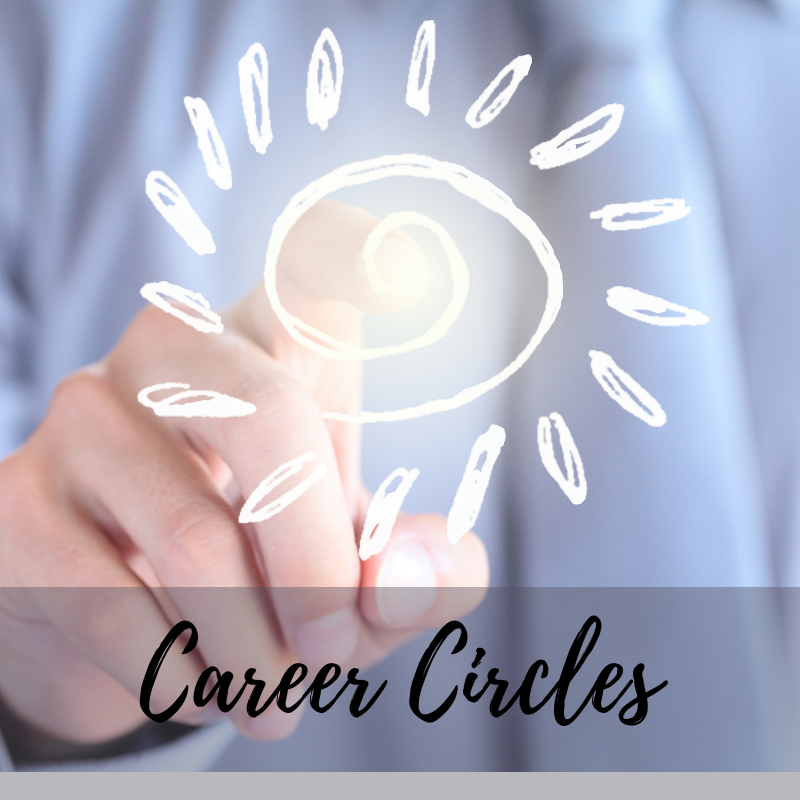Think career planning is a one-time event? Think again!
Like so many wage earners, do you mistakenly share the notion that career planning is only meant for new entrants to the workforce? That people in their early twenties will choose the career of their dreams and stick with it throughout their lives? If you answered yes, then I’m sorry to tell you, my friends, that you need to think again.
The world of work has changed. Futurists like Rohit Talwar predict today’s children will hold 20+ jobs in their lives and take ten different career paths. Not only is remaining in a single position for any length of time unbeneficial, it’s downright risky. As disruptive technology continues to replace traditional roles at lightning speed, the longer one remains static, the greater the chance they’ll find themselves with outdated skills when (not if) they’re forced to move on.
But what about job satisfaction, you ask? Don’t we spend 70% of our entire lives at work? Do we not need stable and meaningful work to create balance and harmony? How do I choose a vocation, an educational path, and a plan for making a positive difference in the world if today’s new economy dictates that I abandon my career goals as soon as I achieve them?
Great questions, all.
Today, as it’s always been, deciding on your career is one of the most important choices you’ll make. It impacts every facet of your life – your income, where you’ll live, when you’ll retire, perhaps even the size of your family.
Solid career planning remains a vital strategy in the quest for finding meaningful and satisfactory work. What’s changed, however, is the frequency with which it occurs. In today’s economy, the key to success is adaptability, along with a commitment to lifelong learning. No matter your age or life stage, it’s no longer sensible to think in terms of having a “job.” Still, instead, as having a career trajectory – the path you take that brings with it the culmination of your skills, titles, inclinations, and education, and the ways they, and the world, transforms as time and technology press on.
THE CAREER CHANGE CIRCLE
Getting comfortable with frequent career change means getting familiar with planning it. Like most successful marketing strategies, the circle begins with the product, which is you – your values, education, skills, and attributes. It continues with researching trends, opportunities, and threats in the marketplace and follows with exploring your options and setting realistic goals. Last, it’s developing a viable action plan and taking your brand to market.
Step One – Self-Assessment
What do you bring to the table? Or better still, what do you want to bring to the table? How well do you know yourself? Determining your value goes beyond taking a personal inventory of your areas of strength and expertise. It involves matching your preferences to suitable options and examining your dreams, passions, and aspirations. It means revealing blind spots and areas of weakness and developing plans to challenge the limiting beliefs that may be holding you back.
Self-assessment tools and career theories abound. While many require the expertise of trained career coaches, psychologists, and employment professionals, the following are several inexpensive and straightforward options to get you started.
Myer’s Briggs Personality Types, Clifton Strengths Finder 34, and Holland’s Theory of Career Choice are worthwhile activities to assist you in matching your personality to suitable job types and environments.
The Johari Window is an effective way to gain awareness of one’s blind spots, demons, and the unknown. It requires you to take stock of your skills and accomplishments and to reach out to others for suggestions and opinions. Anonymous surveys like 360° Reach are useful tools for determining the unknown and tend to garner honest responses. Many of these, including 360° Reach, offer free options.
Self-awareness helps you identify the type of work you’d do well and will enjoy. It also assists with targeting your job search and to confidently answer essential questions like:
📌 What can I do for an employer?
📌 Where can I add value?
📌 What are my unique gifts and talents?
Step Two – Researching The Forces That Shape The Job Market
Before embarking on a career path, you must explore the viability of the field, industry, or corporation you choose to target. The problem with predicting future trends, however, is knowing where to begin. While you can watch the news, read industry periodicals, and become aware of technological advancements (especially in your areas of expertise), your best chance for keeping ahead of the curve is following trusted researchers, leaders, and experts. Like these:
- The Blog at Workplace IntelligenceInsights at Gartner Inc.
- Insights at Deloitte
- LinkedIn Learning and Development
- McKinsey & Company – The Future of Work
- KPMG Insights
- Finances Online
If you’ve chosen several organizations as possible employers, obtain copies of their annual reports, check out their websites, and watch for posts and updates on their LinkedIn page. Follow their executive’s LinkedIn posts and updates. Most importantly, find company employees – both current and past – to reach out to, asking for advice and information about the company’s culture, values, and communication practices and whether they’d recommend it as a place to work. Hint, LinkedIn’s search and filter feature makes this task a breeze.
Step Three – Weighing Options
When you are prepared and self-aware, you will better understand the options that ultimately lead to planning your actions and setting realistic goals. Managing your options is as simple as:
- Distinguishing key fields – not jobs – where you wish to work.
- Studying job descriptions across those key areas and determining five or six competencies that are common in all.
- Identifying competency gaps between your current skills and abilities against competencies needed to perform the work.
- Implementing strategies for closing competency gaps, i.e., enrolling in classes, creating a savings plan, conducting informational interviews, or finding creative ways to gain hands-on experience (volunteering and interning, etc.).
- Staying on track using project management tools like the Critical Path Method or Gantt Charts to break your strategic plans into manageable and prioritized tasks.
Step Four – Take Action With A Personal Marketing Plan
“It’s not the best product that wins but the best-known one that wins.” Jia Wertz, Entrepreneur and documentary filmmaker.
To fully articulate your value, you must create branded and unique marketing tools, i.e., an optimized LinkedIn profile, a targeted resume, a cover letter, and business cards.
Next, you need to develop a strategic methodology for getting your assets in front of the right audience, one that is aligned with your skills and passion. Marketing involves advertising, image creation, and stirring market awareness without persuading the buyer directly. The best way to achieve this is to network prolifically!
I have a saying, “You never know who can help you until they do.” The following are tried and true ways to engage with your targeted audience:
- Engage on LinkedIn and other digital platforms.
- Create job alerts through LinkedIn.
- Optimize your LinkedIn profile with keywords to attract recruiters and hiring managers.
- Leverage your networks and current relationships, i.e., family, friends, co-workers, bosses, teachers, and cohorts.
- Attend job fairs.
- Join a professional organization.
- Volunteer.
- Secure an internship in a related field.
- Bypass HR by connecting with people in the department of your chosen organizations.
Next, get very good at interviewing!
Develop answers to behavioral interview questions – the ones that begin with, “Can you tell me about a time when you…?” Many clients stress over which questions to prepare for but there is a relatively easy approach. Look for the required competencies in a sampling of ten or so job descriptions in your chosen field and then reach into your past to determine times when you’ve used those competencies. To be on the safe side, come up with several scenarios (in case they come up in another question), and then use the STAR approach to describe them:
S – Describe the Situation.
T – What was your Task in the situation?
A – What Action did you take?
R – What positive Result(s) did your action garner.
Practice interviewing with a friend, in front of the mirror, or by videoing yourself and playing it back. Take note of your unconscious quirks, like frequently saying “Um,” or flipping your hair, and biting your lip to name a few. Now is the time to be hard on yourself – better than AFTER the interview when it’s too late to do anything about it.
When you settle into the job of your dreams, look around and look around often; in other words, do not become complacent. Keep your finger on the pulse of emerging trends and new technologies; make Step 2 your new best friend.

